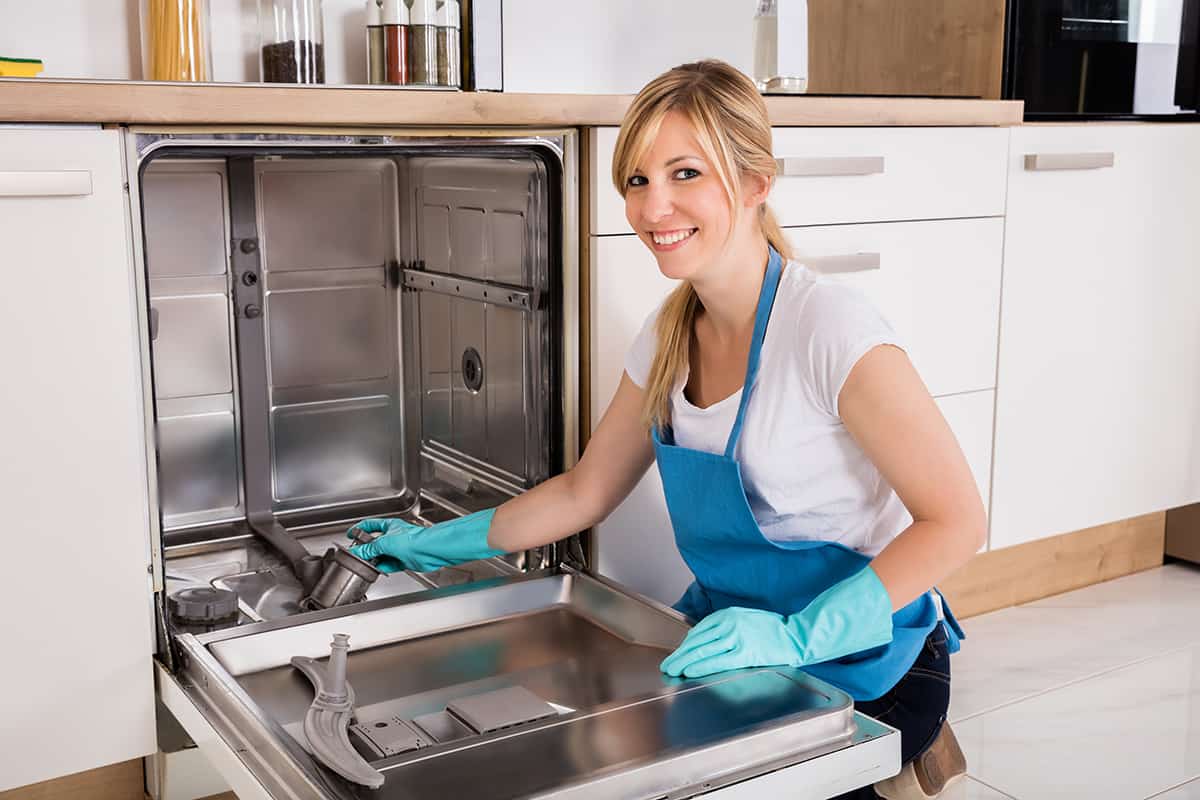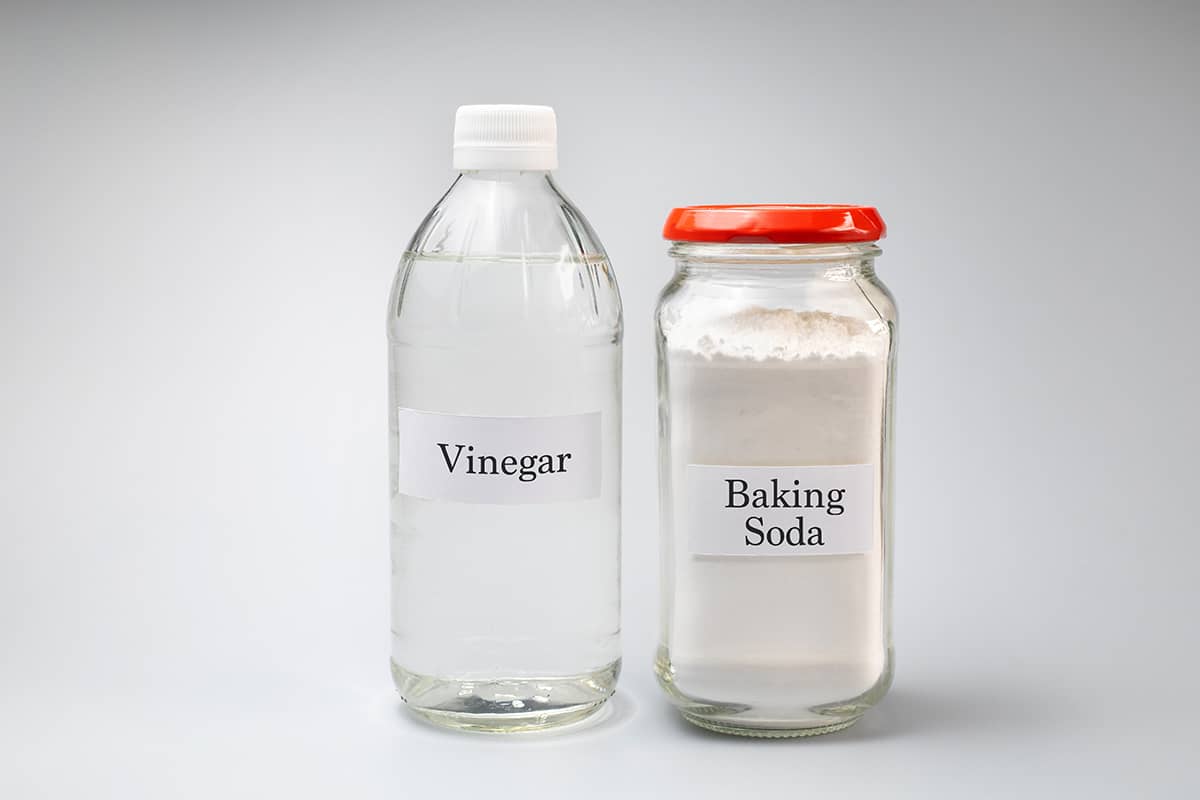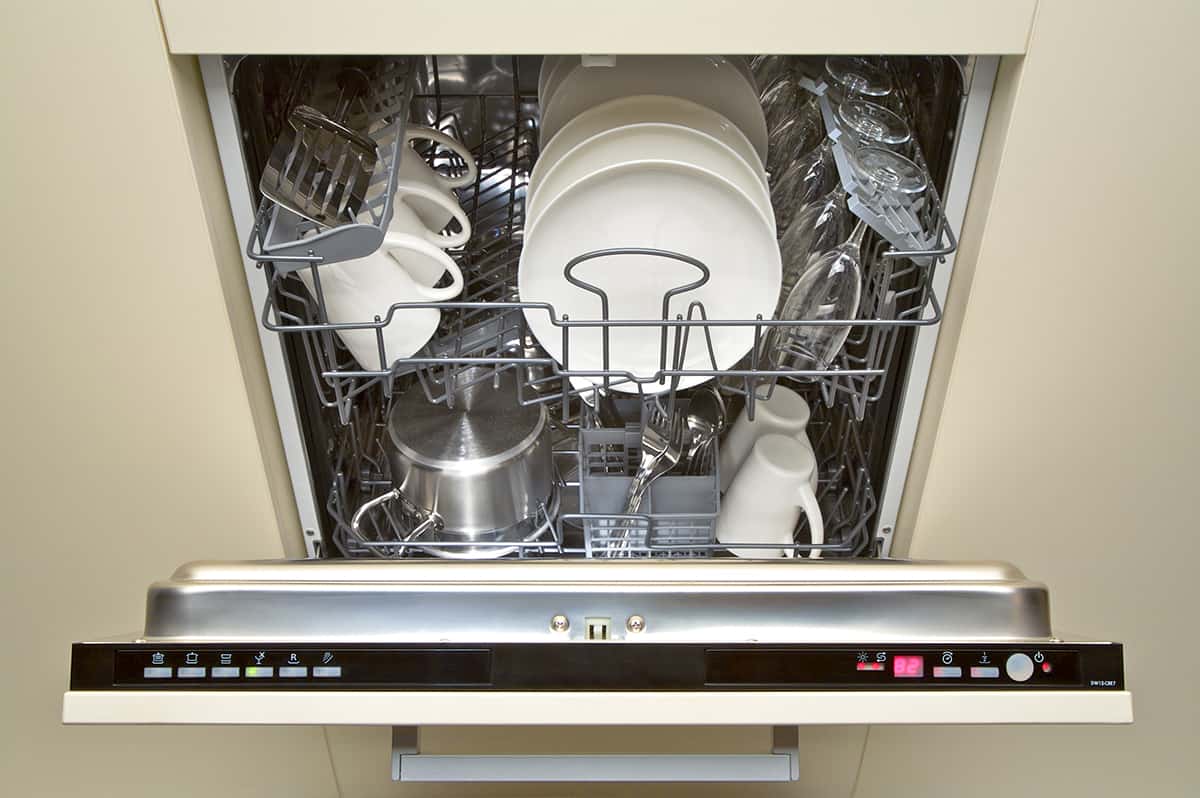Dishwashers are essential appliances in many households, helping us keep our dishes clean and save time in the process. However, over time, your dishwasher can accumulate food particles, grease, and grime, which can lead to unpleasant odors and decreased performance.
To deep clean a dishwasher, you should:
- Turn off and unplug the dishwasher
- Empty and dismantle the dishwasher
- Clean the spray arms, filters, and interior surfaces
- Address the exterior, including the control panel and door
- Deodorize using vinegar and baking soda
In this article, we will provide a step-by-step guide to help you deep clean your dishwasher, ensuring optimal performance and a longer lifespan for your appliance.
Preparing for the Deep Clean
Before you start deep cleaning your dishwasher, gather the supplies you’ll need.
- White vinegar
- Baking soda
- Dish soap
- Toothbrush
- Microfiber cloth
- Screwdriver (if needed)
Now, turn off and unplug the dishwasher to ensure your safety while cleaning. Next, remove any dishes from the dishwasher. This will give you access to all the parts that need cleaning. Make sure you have a clear area to work in, as you’ll need space to place dishwasher components while you clean them.
Deep-Cleaning the Dishwasher’s Interior

The next step in deep-cleaning a dishwasher is to clean the interior of food remnants, limescale buildup, and other funky contaminants.
1. Dismantling the Dishwasher
To start deep-cleaning your dishwasher’s interior, first remove the bottom and top racks. This will give you more space to work with. Next, carefully take off the spray arms. They usually twist or snap off easily. Make sure to set them aside safely, as you’ll need to clean them later.
2. Cleaning the Spray Arms
Clean the spray arms by rinsing them under running water to remove loose debris. Use a toothbrush to gently scrub away any stuck-on food particles. Make sure to clear the spray arm holes, as these can get clogged and affect the dishwasher’s performance. Once the spray arms are clean, set them aside to dry.
3. Cleaning the Filters
The filters in your dishwasher help catch food particles and keep the water clean during a wash cycle. We explained how to clean the filter in our article ‘ How to Clean a GE Dishwasher Filter‘. You can do the same for your dishwasher by following these steps.
Locate and remove the filters, which are usually found at the bottom of the dishwasher.
Soak the filters in warm, soapy water for about 15 minutes. Then, use a toothbrush to scrub away any remaining debris. Rinse the filters thoroughly under running water and put them back in the dishwasher once they are clean and dry.
4. Tackling the Interior Surfaces
Now, it’s time to clean the interior surfaces of your dishwasher. Use a damp microfiber cloth to wipe down the door seal. This helps prevent mold and mildew from forming. Next, clean the walls and bottom of the dishwasher using a mixture of dish soap and water. Gently scrub with a cloth or sponge to remove any grime, and then rinse with clean water.
For stubborn stains or hard-to-reach areas, use an old toothbrush to scrub gently. Pay special attention to corners and crevices where dirt can accumulate. Be sure to also remove and clean the utensil holder by washing it with warm, soapy water. Dry it thoroughly before placing it back into the dishwasher.
5. Reassembling the Dishwasher
Once you have cleaned all the components, it’s time to put your dishwasher back together. Start by reattaching the spray arms, ensuring they are secure and properly aligned. Then, slide the top and bottom racks back into their respective positions. Double-check that all parts are in place and secure before moving on.
The Dishwasher’s Exterior
With the interior squeaky clean, we can now focus our efforts on the exterior.
1. Cleaning the Control Panel
The control panel is an important part of your dishwasher. It’s where you select the wash cycles and options. To keep it clean and functioning properly, follow these steps:
- Choose a cleaner that’s safe for the control panel’s material. You can use a mild all-purpose cleaner or a mixture of dish soap and water.
- Apply the cleaner to a microfiber cloth. Be sure not to spray the cleaner directly onto the control panel, as this can cause damage.
- Gently wipe the control panel, avoiding pressing any buttons or switches. Make sure to clean around the buttons, as dirt can collect in these areas.
- Dry the control panel with a clean, dry cloth to prevent any streaks or residue.
2. Polishing the Dishwasher Door
A clean dishwasher door not only looks nice but also helps prevent the buildup of dirt and grime. Depending on the material of your dishwasher door, follow these cleaning tips:
For stainless steel doors
- Use a stainless steel cleaner or a mixture of white vinegar and water. This will help remove fingerprints and smudges.
- Apply the cleaner to a microfiber cloth. Avoid spraying the cleaner directly onto the door.
- Wipe the door following the grain of the stainless steel. This helps prevent streaks and gives the door a polished look.
- Buff the door with a clean, dry cloth for a final shine.
For plastic or enameled doors
- Use a mixture of dish soap and water. This will help remove dirt and stains.
- Dip a microfiber cloth or sponge into the soapy water, and wring it out so it’s damp but not dripping.
- Wipe the door with a damp cloth or sponge. Be sure to clean around the edges and handle, where dirt can accumulate.
- Rinse the cloth or sponge with clean water, and then wipe the door again to remove any soap residue.
- Dry the door with a clean, dry cloth to prevent streaks.
Deodorizing the Dishwasher

Even after cleaning, your dishwasher might have lingering smells. Deodorizing helps to eliminate odors and gives your dishwasher a fresh scent. Here are some easy ways to deodorize your dishwasher:
Using Vinegar
- Vinegar is an effective natural dishwasher cleaner and deodorizer. Fill a dishwasher-safe container, like a small bowl or measuring cup, with white vinegar. Place it on the bottom rack of your empty dishwasher.
- Run a hot water cycle without detergent. The vinegar will help break down any remaining grime and remove odors.
- Once the cycle is complete, remove the container and discard the vinegar.
Using Baking Soda
- After the vinegar cycle, sprinkle about a cup of baking soda on the bottom of the dishwasher.
- Run a short, hot water cycle. The baking soda will help neutralize any lingering smells and give your dishwasher a fresh scent.
- After the cycle is complete, your dishwasher should smell clean and fresh.
Other Deodorizing Options
If you prefer, you can use commercial dishwasher cleaners or even lemon peels to deodorize your dishwasher. Just make sure to follow the manufacturer’s instructions for proper use.
FAQs
1. How often should I deep clean my dishwasher?
It’s a good idea to deep clean your dishwasher about once every three months. This helps to remove buildup, improve performance, and extend the life of your appliance. You may need to clean it more often if you notice unpleasant odors or decreased cleaning performance.
2. Is it safe to use bleach in my dishwasher?
Bleach can be used in small amounts to clean and sanitize a dishwasher, but be cautious. Never use bleach if your dishwasher has a stainless steel interior, as it can cause damage. If you decide to use bleach, mix a small amount with water and follow the manufacturer’s guidelines for safe use.
3. Can I use commercial dishwasher cleaners instead of vinegar and baking soda?
Yes, you can use commercial dishwasher cleaners like Affresh to deep clean and deodorize your dishwasher. These products are specially formulated to remove buildup and odors. Be sure to follow the manufacturer’s instructions for proper use, as each product may have different guidelines.






